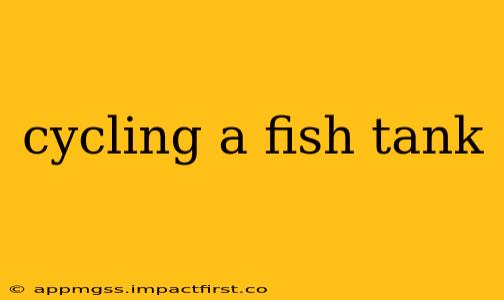Cycling a fish tank, also known as establishing the nitrogen cycle, is the crucial first step before introducing any fish. It's a process that creates a stable environment where beneficial bacteria break down harmful waste products, ensuring a healthy and thriving aquarium. Ignoring this vital step can lead to ammonia poisoning and the death of your fish. This comprehensive guide will walk you through the entire process, answering common questions and providing expert advice to help you successfully cycle your tank.
What is the Nitrogen Cycle?
The nitrogen cycle is a natural process that occurs in all aquatic environments. It involves the breakdown of fish waste (ammonia), nitrite, and finally into nitrate, a less harmful form of nitrogen. This process relies on beneficial bacteria – Nitrosomonas converts ammonia to nitrite, and Nitrobacter converts nitrite to nitrate. Establishing these bacteria colonies in your tank is the essence of cycling.
How Long Does it Take to Cycle a Fish Tank?
The time it takes to cycle a fish tank can vary, typically ranging from 4-8 weeks, depending on several factors including water temperature, the amount of initial bacteria added (through methods like using filter media from an established tank), and the cycling method employed. Patience is key!
What are the Different Methods for Cycling a Fish Tank?
There are several ways to cycle a fish tank, each with its own pros and cons:
1. Fish-in Cycling:
This method involves adding fish to the tank from the start and monitoring water parameters closely. It's considered riskier as it exposes the fish to potentially toxic ammonia and nitrite levels. Close monitoring and frequent partial water changes are crucial to minimize the risk to your fish.
2. Fish-less Cycling:
This safer and more controlled method uses an ammonia source (pure ammonia or fish food) to stimulate the growth of beneficial bacteria without exposing fish to harmful levels of toxins. Regular testing is necessary to track the progress of the cycle. This is the generally recommended method for beginners.
3. Using Filter Media from an Established Tank:
Adding filter media or gravel from a mature, healthy aquarium significantly speeds up the cycling process by introducing established beneficial bacteria into your new tank.
How to Fish-less Cycle a Fish Tank: A Step-by-Step Guide
-
Set up your aquarium: This includes filling the tank with water, adding substrate, decorations, and installing the filter and heater.
-
Add an ammonia source: Introduce a small amount of pure ammonia (look for a solution for cleaning purposes without added detergents) or a pinch of fish food (about 1/4 teaspoon per 5 gallons) into the tank. Aim for an initial ammonia reading of approximately 2-4 ppm (parts per million).
-
Monitor water parameters daily: Use a reliable liquid test kit to measure ammonia (NH3/NH4), nitrite (NO2), and nitrate (NO3) levels. Testing strips are less accurate for this process.
-
Add more ammonia as needed: Once ammonia levels drop to 0, add more to keep the level around 2-4 ppm to sustain the bacterial growth. This helps the bacteria grow strong and ensures the cycle doesn't stall.
-
The Cycle is Complete: Your tank is cycled when you observe the following pattern: Ammonia added -> Ammonia converted to nitrite (NO2) -> Nitrite converted to nitrate (NO3). All levels should eventually read 0 ppm for ammonia and nitrite. A nitrate reading will remain, indicating a successful cycle. Now you can start introducing your fish gradually.
What are the Signs of a Fully Cycled Tank?
- Zero ammonia (NH3/NH4) and nitrite (NO2) levels: These are toxic to fish.
- Nitrate (NO3) levels are present: This indicates the presence of beneficial bacteria.
- Stable water parameters: Your water parameters should remain relatively consistent.
What to Do if My Tank Isn't Cycling?
If your tank isn't cycling properly, there could be several reasons:
- Insufficient bacteria: Add more filter media from a healthy tank to jumpstart the process.
- Chloramine or chlorine in the water: Ensure you use a water conditioner to neutralize these chemicals.
- Inaccurate testing: Double-check your test results with a different test kit.
- Not enough ammonia: Increase the ammonia source slightly.
What are some common mistakes to avoid when cycling a fish tank?
- Using tap water without dechlorination: Chlorine and chloramine in tap water will kill the beneficial bacteria.
- Adding too much ammonia at once: This can create harmful spikes that won't allow bacteria to establish.
- Being impatient: The nitrogen cycle takes time. Do not rush the process.
- Not testing regularly: Regular testing is essential to monitor progress.
Cycling a fish tank may seem daunting at first, but by understanding the process and following these steps, you can create a healthy and thriving environment for your aquatic friends. Remember, patience and accurate testing are your best allies. Happy cycling!
